Applied Corporate Strategy: Zara's Online Strategy Analysis Report
VerifiedAdded on 2021/02/21
|19
|4256
|185
Report
AI Summary
This report provides a comprehensive analysis of Zara's online strategy, focusing on its external and internal environments. The external analysis utilizes PESTLE and Porter's Five Forces frameworks to identify opportunities and threats within the fashion retail industry. The internal analysis employs VRIO analysis to assess Zara's resources and key competencies, highlighting its strengths and weaknesses. The report examines Zara's use of technology, its supply chain, and its marketing strategies. The report also evaluates the suitability, feasibility, and accessibility of Zara's online strategy. The report concludes with an evaluation of Zara's strategic choices, offering insights into its competitive advantage and future prospects.
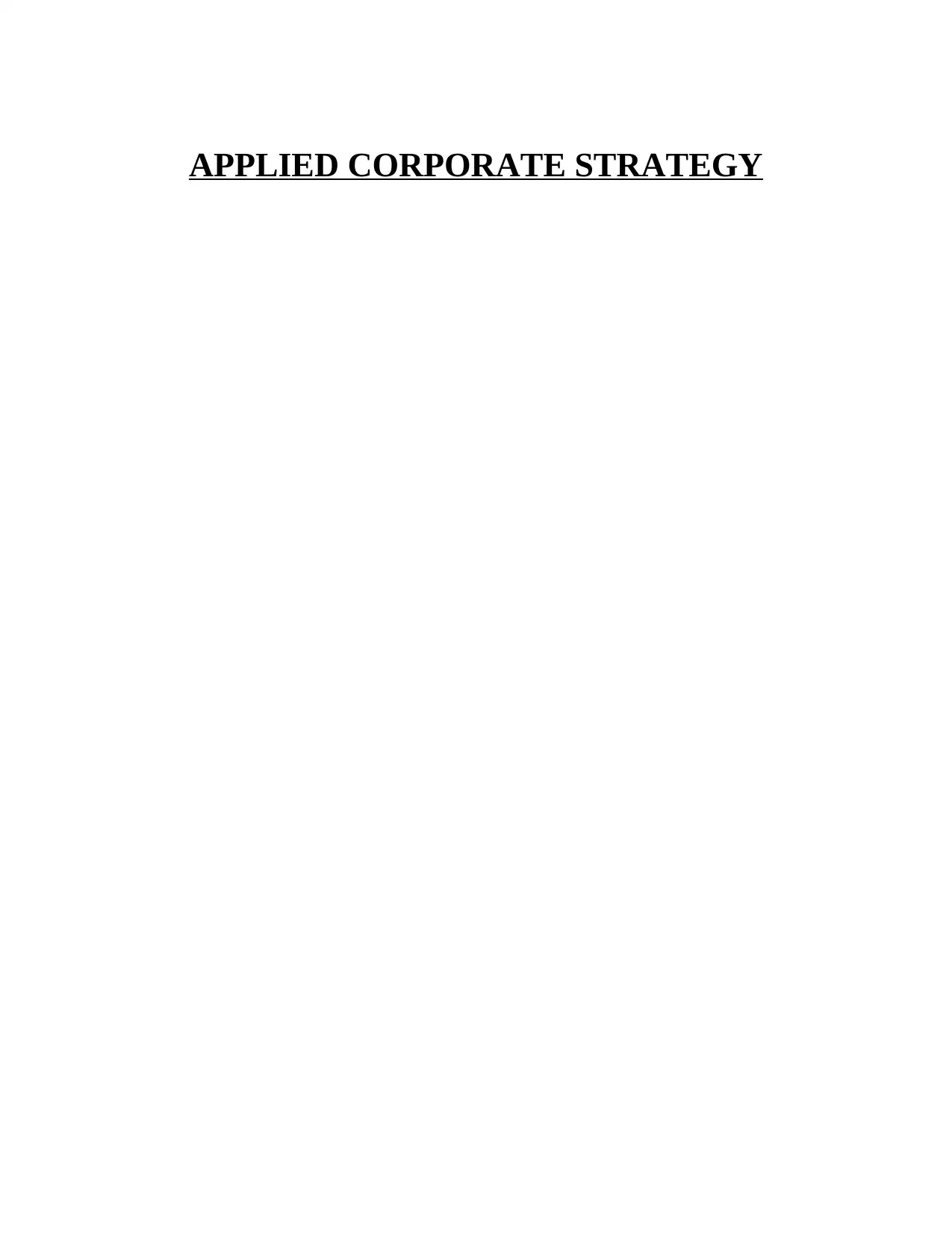
APPLIED CORPORATE STRATEGY
Paraphrase This Document
Need a fresh take? Get an instant paraphrase of this document with our AI Paraphraser
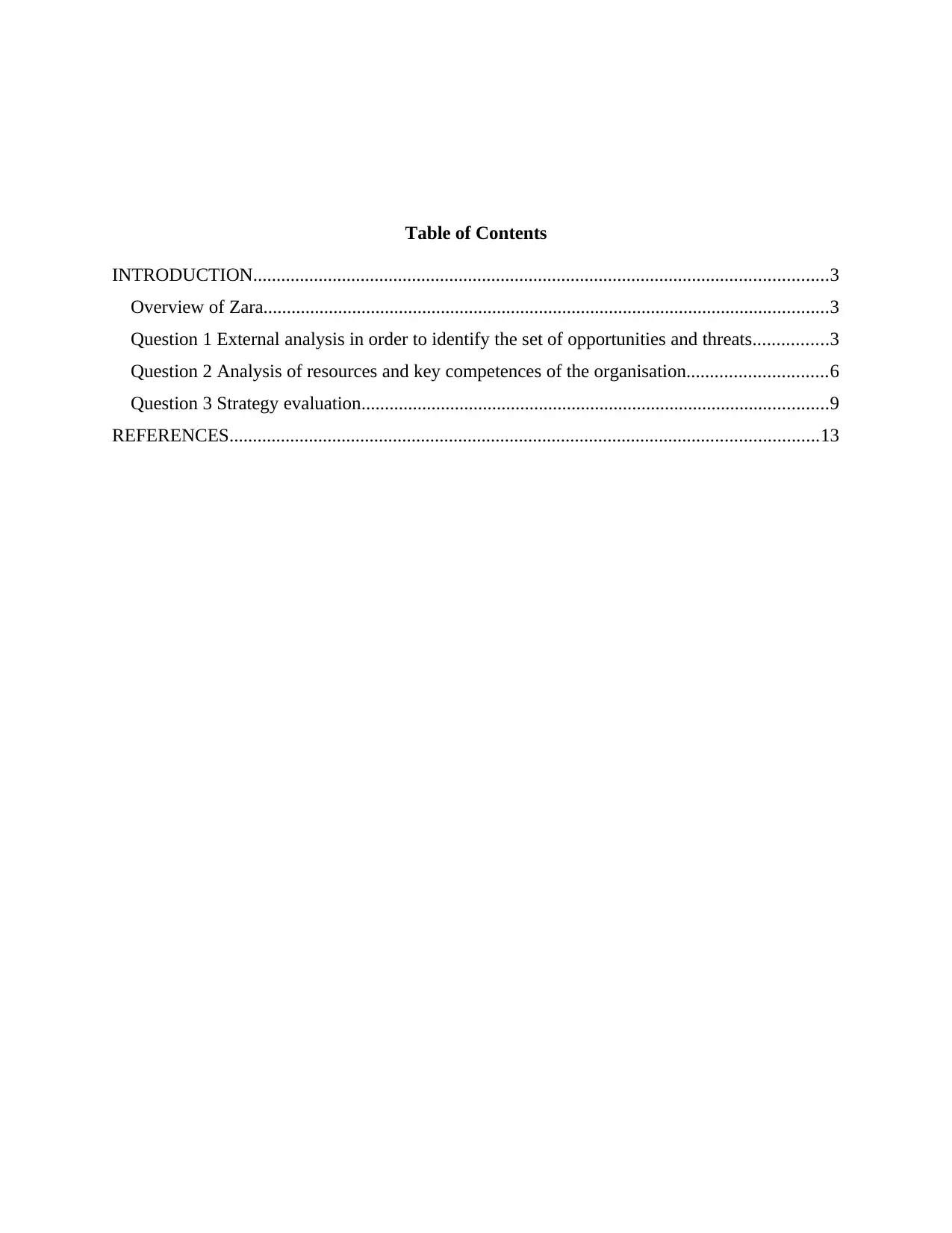
Table of Contents
INTRODUCTION...........................................................................................................................3
Overview of Zara.........................................................................................................................3
Question 1 External analysis in order to identify the set of opportunities and threats................3
Question 2 Analysis of resources and key competences of the organisation..............................6
Question 3 Strategy evaluation....................................................................................................9
REFERENCES..............................................................................................................................13
INTRODUCTION...........................................................................................................................3
Overview of Zara.........................................................................................................................3
Question 1 External analysis in order to identify the set of opportunities and threats................3
Question 2 Analysis of resources and key competences of the organisation..............................6
Question 3 Strategy evaluation....................................................................................................9
REFERENCES..............................................................................................................................13
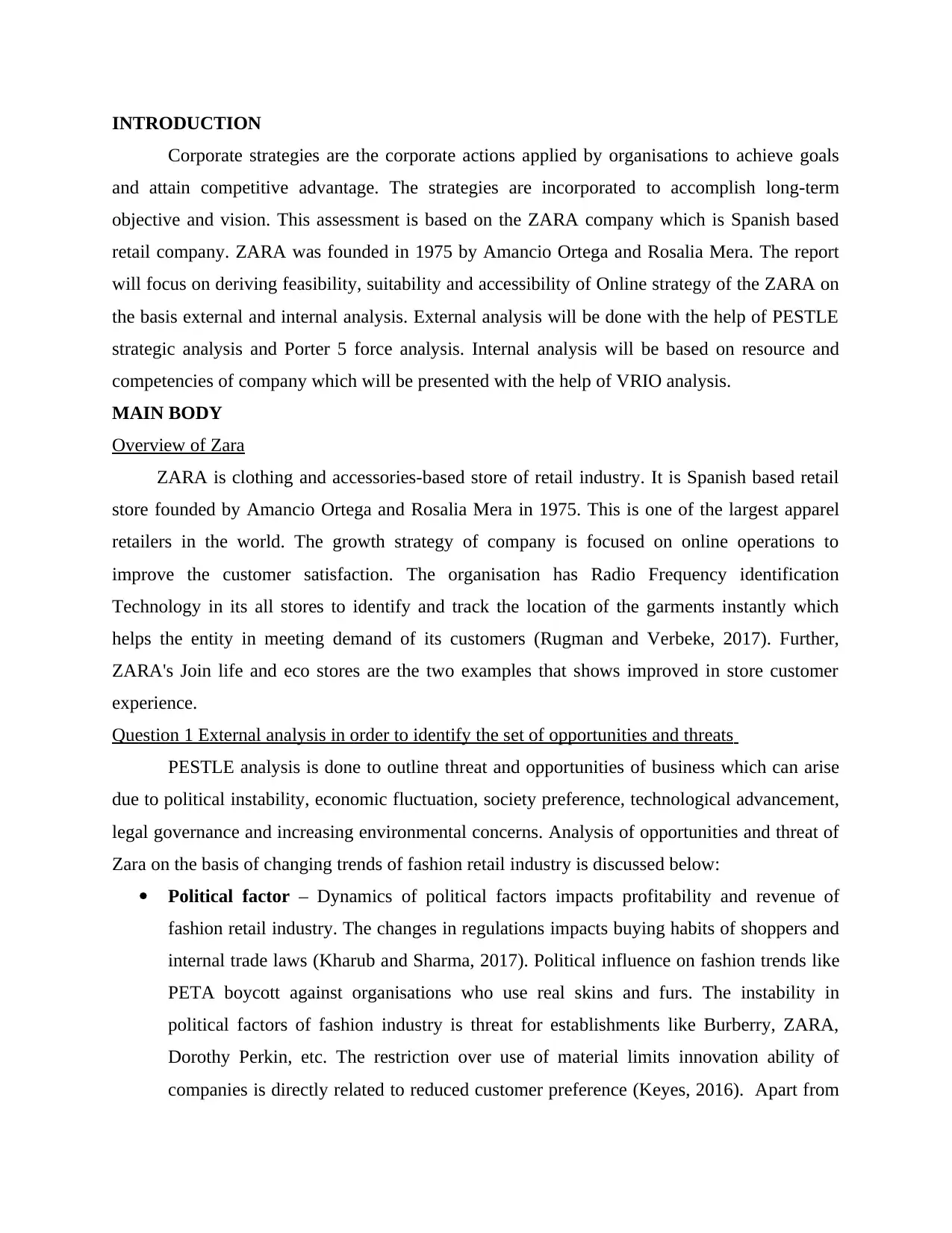
INTRODUCTION
Corporate strategies are the corporate actions applied by organisations to achieve goals
and attain competitive advantage. The strategies are incorporated to accomplish long-term
objective and vision. This assessment is based on the ZARA company which is Spanish based
retail company. ZARA was founded in 1975 by Amancio Ortega and Rosalia Mera. The report
will focus on deriving feasibility, suitability and accessibility of Online strategy of the ZARA on
the basis external and internal analysis. External analysis will be done with the help of PESTLE
strategic analysis and Porter 5 force analysis. Internal analysis will be based on resource and
competencies of company which will be presented with the help of VRIO analysis.
MAIN BODY
Overview of Zara
ZARA is clothing and accessories-based store of retail industry. It is Spanish based retail
store founded by Amancio Ortega and Rosalia Mera in 1975. This is one of the largest apparel
retailers in the world. The growth strategy of company is focused on online operations to
improve the customer satisfaction. The organisation has Radio Frequency identification
Technology in its all stores to identify and track the location of the garments instantly which
helps the entity in meeting demand of its customers (Rugman and Verbeke, 2017). Further,
ZARA's Join life and eco stores are the two examples that shows improved in store customer
experience.
Question 1 External analysis in order to identify the set of opportunities and threats
PESTLE analysis is done to outline threat and opportunities of business which can arise
due to political instability, economic fluctuation, society preference, technological advancement,
legal governance and increasing environmental concerns. Analysis of opportunities and threat of
Zara on the basis of changing trends of fashion retail industry is discussed below:
Political factor – Dynamics of political factors impacts profitability and revenue of
fashion retail industry. The changes in regulations impacts buying habits of shoppers and
internal trade laws (Kharub and Sharma, 2017). Political influence on fashion trends like
PETA boycott against organisations who use real skins and furs. The instability in
political factors of fashion industry is threat for establishments like Burberry, ZARA,
Dorothy Perkin, etc. The restriction over use of material limits innovation ability of
companies is directly related to reduced customer preference (Keyes, 2016). Apart from
Corporate strategies are the corporate actions applied by organisations to achieve goals
and attain competitive advantage. The strategies are incorporated to accomplish long-term
objective and vision. This assessment is based on the ZARA company which is Spanish based
retail company. ZARA was founded in 1975 by Amancio Ortega and Rosalia Mera. The report
will focus on deriving feasibility, suitability and accessibility of Online strategy of the ZARA on
the basis external and internal analysis. External analysis will be done with the help of PESTLE
strategic analysis and Porter 5 force analysis. Internal analysis will be based on resource and
competencies of company which will be presented with the help of VRIO analysis.
MAIN BODY
Overview of Zara
ZARA is clothing and accessories-based store of retail industry. It is Spanish based retail
store founded by Amancio Ortega and Rosalia Mera in 1975. This is one of the largest apparel
retailers in the world. The growth strategy of company is focused on online operations to
improve the customer satisfaction. The organisation has Radio Frequency identification
Technology in its all stores to identify and track the location of the garments instantly which
helps the entity in meeting demand of its customers (Rugman and Verbeke, 2017). Further,
ZARA's Join life and eco stores are the two examples that shows improved in store customer
experience.
Question 1 External analysis in order to identify the set of opportunities and threats
PESTLE analysis is done to outline threat and opportunities of business which can arise
due to political instability, economic fluctuation, society preference, technological advancement,
legal governance and increasing environmental concerns. Analysis of opportunities and threat of
Zara on the basis of changing trends of fashion retail industry is discussed below:
Political factor – Dynamics of political factors impacts profitability and revenue of
fashion retail industry. The changes in regulations impacts buying habits of shoppers and
internal trade laws (Kharub and Sharma, 2017). Political influence on fashion trends like
PETA boycott against organisations who use real skins and furs. The instability in
political factors of fashion industry is threat for establishments like Burberry, ZARA,
Dorothy Perkin, etc. The restriction over use of material limits innovation ability of
companies is directly related to reduced customer preference (Keyes, 2016). Apart from
⊘ This is a preview!⊘
Do you want full access?
Subscribe today to unlock all pages.

Trusted by 1+ million students worldwide
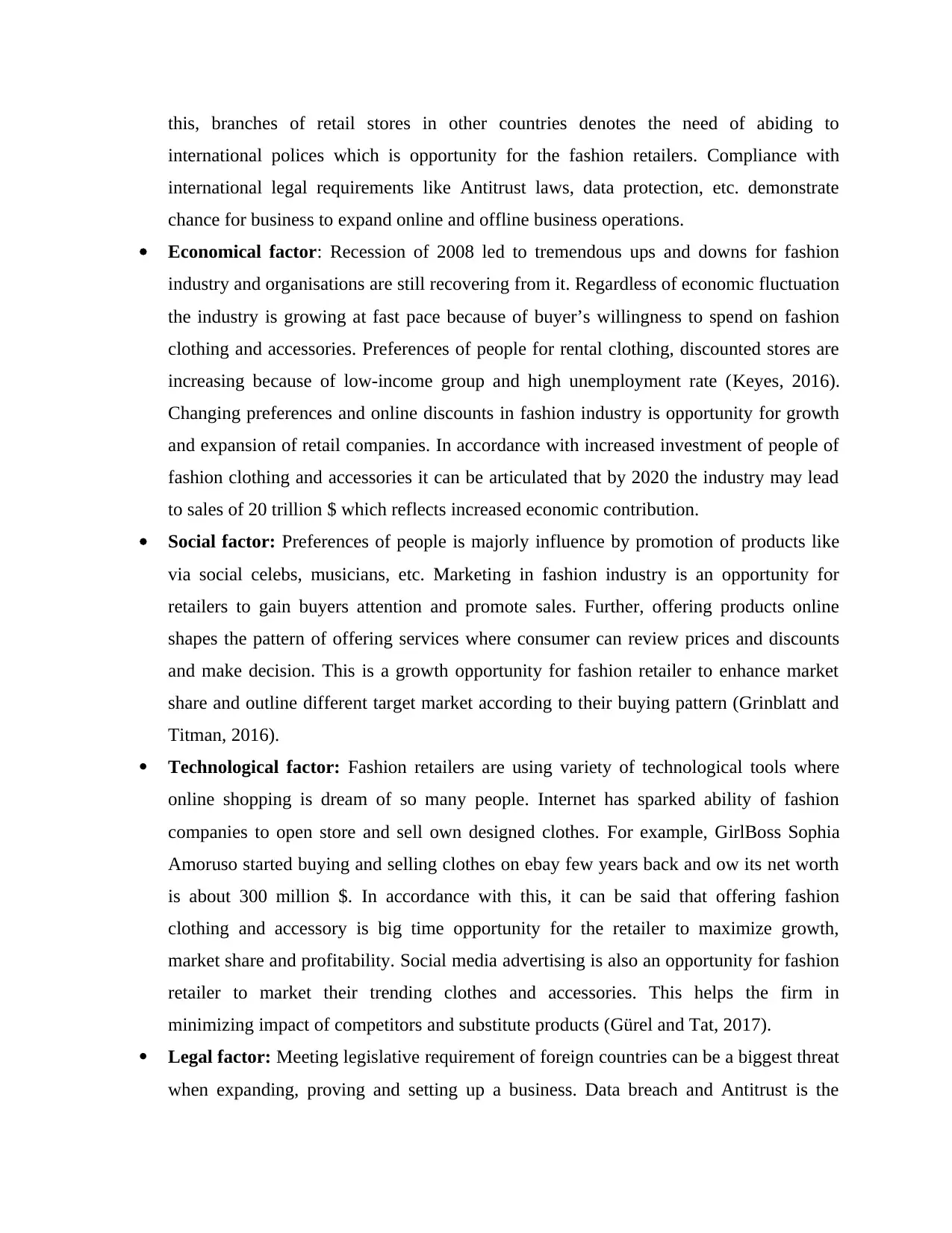
this, branches of retail stores in other countries denotes the need of abiding to
international polices which is opportunity for the fashion retailers. Compliance with
international legal requirements like Antitrust laws, data protection, etc. demonstrate
chance for business to expand online and offline business operations.
Economical factor: Recession of 2008 led to tremendous ups and downs for fashion
industry and organisations are still recovering from it. Regardless of economic fluctuation
the industry is growing at fast pace because of buyer’s willingness to spend on fashion
clothing and accessories. Preferences of people for rental clothing, discounted stores are
increasing because of low-income group and high unemployment rate (Keyes, 2016).
Changing preferences and online discounts in fashion industry is opportunity for growth
and expansion of retail companies. In accordance with increased investment of people of
fashion clothing and accessories it can be articulated that by 2020 the industry may lead
to sales of 20 trillion $ which reflects increased economic contribution.
Social factor: Preferences of people is majorly influence by promotion of products like
via social celebs, musicians, etc. Marketing in fashion industry is an opportunity for
retailers to gain buyers attention and promote sales. Further, offering products online
shapes the pattern of offering services where consumer can review prices and discounts
and make decision. This is a growth opportunity for fashion retailer to enhance market
share and outline different target market according to their buying pattern (Grinblatt and
Titman, 2016).
Technological factor: Fashion retailers are using variety of technological tools where
online shopping is dream of so many people. Internet has sparked ability of fashion
companies to open store and sell own designed clothes. For example, GirlBoss Sophia
Amoruso started buying and selling clothes on ebay few years back and ow its net worth
is about 300 million $. In accordance with this, it can be said that offering fashion
clothing and accessory is big time opportunity for the retailer to maximize growth,
market share and profitability. Social media advertising is also an opportunity for fashion
retailer to market their trending clothes and accessories. This helps the firm in
minimizing impact of competitors and substitute products (Gürel and Tat, 2017).
Legal factor: Meeting legislative requirement of foreign countries can be a biggest threat
when expanding, proving and setting up a business. Data breach and Antitrust is the
international polices which is opportunity for the fashion retailers. Compliance with
international legal requirements like Antitrust laws, data protection, etc. demonstrate
chance for business to expand online and offline business operations.
Economical factor: Recession of 2008 led to tremendous ups and downs for fashion
industry and organisations are still recovering from it. Regardless of economic fluctuation
the industry is growing at fast pace because of buyer’s willingness to spend on fashion
clothing and accessories. Preferences of people for rental clothing, discounted stores are
increasing because of low-income group and high unemployment rate (Keyes, 2016).
Changing preferences and online discounts in fashion industry is opportunity for growth
and expansion of retail companies. In accordance with increased investment of people of
fashion clothing and accessories it can be articulated that by 2020 the industry may lead
to sales of 20 trillion $ which reflects increased economic contribution.
Social factor: Preferences of people is majorly influence by promotion of products like
via social celebs, musicians, etc. Marketing in fashion industry is an opportunity for
retailers to gain buyers attention and promote sales. Further, offering products online
shapes the pattern of offering services where consumer can review prices and discounts
and make decision. This is a growth opportunity for fashion retailer to enhance market
share and outline different target market according to their buying pattern (Grinblatt and
Titman, 2016).
Technological factor: Fashion retailers are using variety of technological tools where
online shopping is dream of so many people. Internet has sparked ability of fashion
companies to open store and sell own designed clothes. For example, GirlBoss Sophia
Amoruso started buying and selling clothes on ebay few years back and ow its net worth
is about 300 million $. In accordance with this, it can be said that offering fashion
clothing and accessory is big time opportunity for the retailer to maximize growth,
market share and profitability. Social media advertising is also an opportunity for fashion
retailer to market their trending clothes and accessories. This helps the firm in
minimizing impact of competitors and substitute products (Gürel and Tat, 2017).
Legal factor: Meeting legislative requirement of foreign countries can be a biggest threat
when expanding, proving and setting up a business. Data breach and Antitrust is the
Paraphrase This Document
Need a fresh take? Get an instant paraphrase of this document with our AI Paraphraser
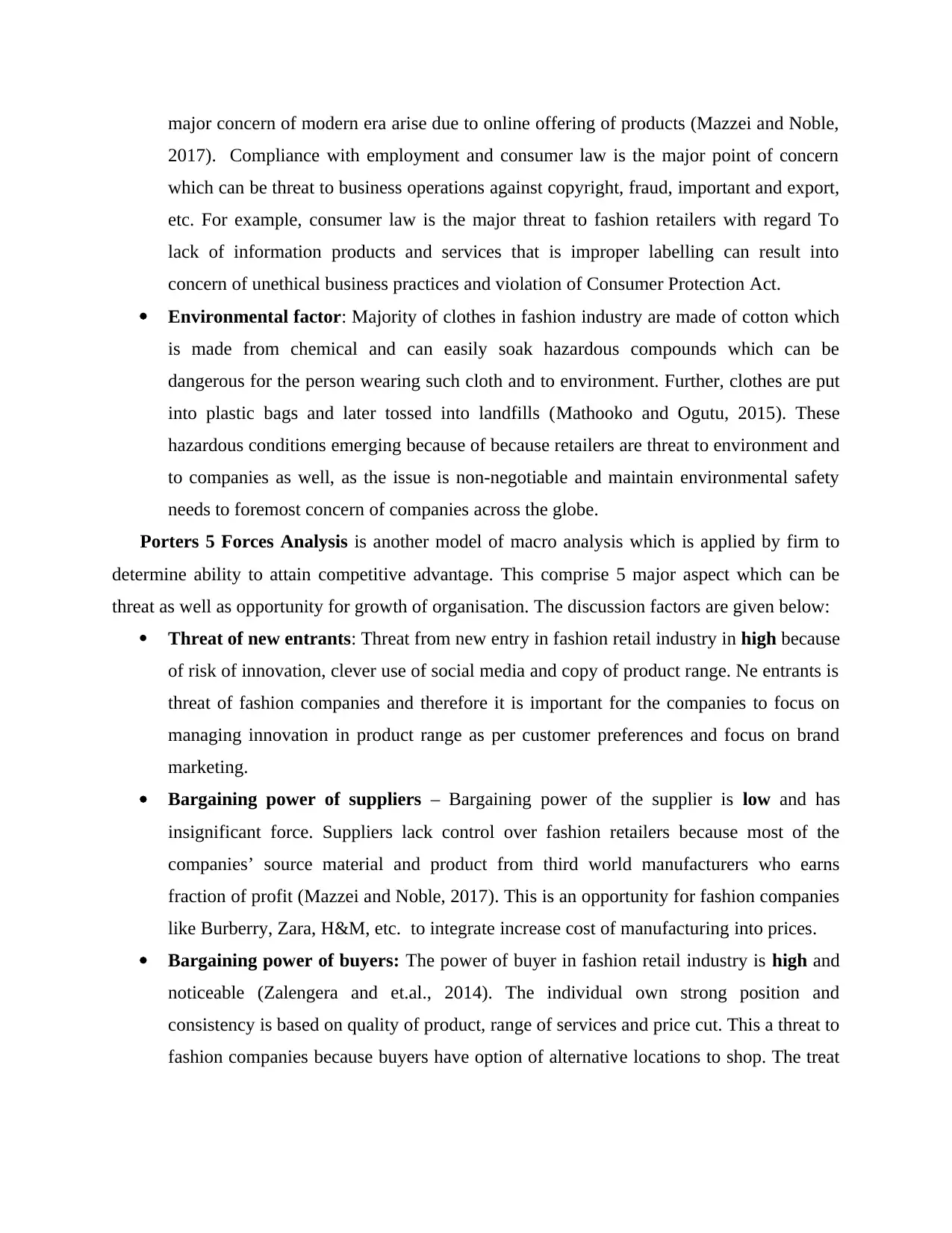
major concern of modern era arise due to online offering of products (Mazzei and Noble,
2017). Compliance with employment and consumer law is the major point of concern
which can be threat to business operations against copyright, fraud, important and export,
etc. For example, consumer law is the major threat to fashion retailers with regard To
lack of information products and services that is improper labelling can result into
concern of unethical business practices and violation of Consumer Protection Act.
Environmental factor: Majority of clothes in fashion industry are made of cotton which
is made from chemical and can easily soak hazardous compounds which can be
dangerous for the person wearing such cloth and to environment. Further, clothes are put
into plastic bags and later tossed into landfills (Mathooko and Ogutu, 2015). These
hazardous conditions emerging because of because retailers are threat to environment and
to companies as well, as the issue is non-negotiable and maintain environmental safety
needs to foremost concern of companies across the globe.
Porters 5 Forces Analysis is another model of macro analysis which is applied by firm to
determine ability to attain competitive advantage. This comprise 5 major aspect which can be
threat as well as opportunity for growth of organisation. The discussion factors are given below:
Threat of new entrants: Threat from new entry in fashion retail industry in high because
of risk of innovation, clever use of social media and copy of product range. Ne entrants is
threat of fashion companies and therefore it is important for the companies to focus on
managing innovation in product range as per customer preferences and focus on brand
marketing.
Bargaining power of suppliers – Bargaining power of the supplier is low and has
insignificant force. Suppliers lack control over fashion retailers because most of the
companies’ source material and product from third world manufacturers who earns
fraction of profit (Mazzei and Noble, 2017). This is an opportunity for fashion companies
like Burberry, Zara, H&M, etc. to integrate increase cost of manufacturing into prices.
Bargaining power of buyers: The power of buyer in fashion retail industry is high and
noticeable (Zalengera and et.al., 2014). The individual own strong position and
consistency is based on quality of product, range of services and price cut. This a threat to
fashion companies because buyers have option of alternative locations to shop. The treat
2017). Compliance with employment and consumer law is the major point of concern
which can be threat to business operations against copyright, fraud, important and export,
etc. For example, consumer law is the major threat to fashion retailers with regard To
lack of information products and services that is improper labelling can result into
concern of unethical business practices and violation of Consumer Protection Act.
Environmental factor: Majority of clothes in fashion industry are made of cotton which
is made from chemical and can easily soak hazardous compounds which can be
dangerous for the person wearing such cloth and to environment. Further, clothes are put
into plastic bags and later tossed into landfills (Mathooko and Ogutu, 2015). These
hazardous conditions emerging because of because retailers are threat to environment and
to companies as well, as the issue is non-negotiable and maintain environmental safety
needs to foremost concern of companies across the globe.
Porters 5 Forces Analysis is another model of macro analysis which is applied by firm to
determine ability to attain competitive advantage. This comprise 5 major aspect which can be
threat as well as opportunity for growth of organisation. The discussion factors are given below:
Threat of new entrants: Threat from new entry in fashion retail industry in high because
of risk of innovation, clever use of social media and copy of product range. Ne entrants is
threat of fashion companies and therefore it is important for the companies to focus on
managing innovation in product range as per customer preferences and focus on brand
marketing.
Bargaining power of suppliers – Bargaining power of the supplier is low and has
insignificant force. Suppliers lack control over fashion retailers because most of the
companies’ source material and product from third world manufacturers who earns
fraction of profit (Mazzei and Noble, 2017). This is an opportunity for fashion companies
like Burberry, Zara, H&M, etc. to integrate increase cost of manufacturing into prices.
Bargaining power of buyers: The power of buyer in fashion retail industry is high and
noticeable (Zalengera and et.al., 2014). The individual own strong position and
consistency is based on quality of product, range of services and price cut. This a threat to
fashion companies because buyers have option of alternative locations to shop. The treat
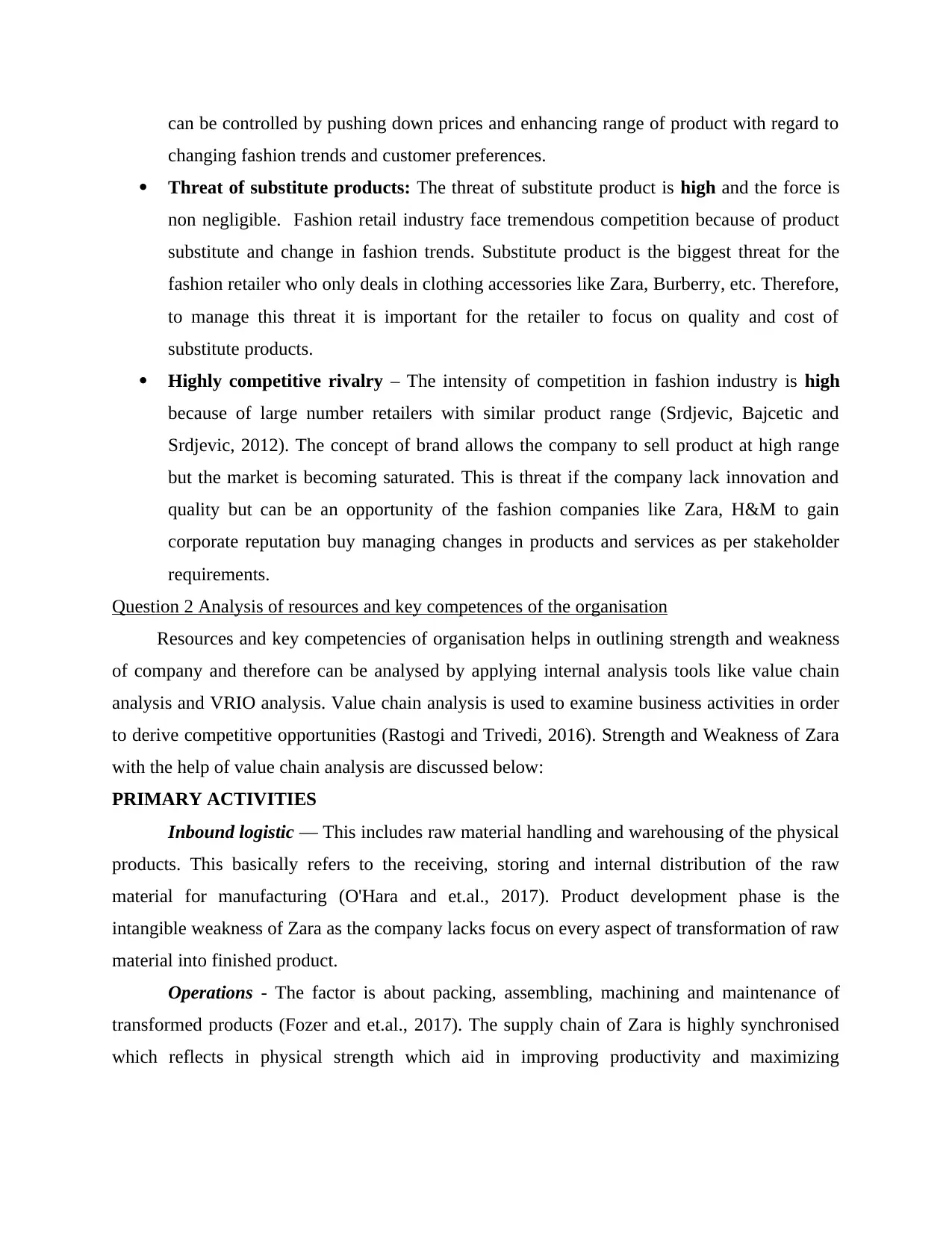
can be controlled by pushing down prices and enhancing range of product with regard to
changing fashion trends and customer preferences.
Threat of substitute products: The threat of substitute product is high and the force is
non negligible. Fashion retail industry face tremendous competition because of product
substitute and change in fashion trends. Substitute product is the biggest threat for the
fashion retailer who only deals in clothing accessories like Zara, Burberry, etc. Therefore,
to manage this threat it is important for the retailer to focus on quality and cost of
substitute products.
Highly competitive rivalry – The intensity of competition in fashion industry is high
because of large number retailers with similar product range (Srdjevic, Bajcetic and
Srdjevic, 2012). The concept of brand allows the company to sell product at high range
but the market is becoming saturated. This is threat if the company lack innovation and
quality but can be an opportunity of the fashion companies like Zara, H&M to gain
corporate reputation buy managing changes in products and services as per stakeholder
requirements.
Question 2 Analysis of resources and key competences of the organisation
Resources and key competencies of organisation helps in outlining strength and weakness
of company and therefore can be analysed by applying internal analysis tools like value chain
analysis and VRIO analysis. Value chain analysis is used to examine business activities in order
to derive competitive opportunities (Rastogi and Trivedi, 2016). Strength and Weakness of Zara
with the help of value chain analysis are discussed below:
PRIMARY ACTIVITIES
Inbound logistic — This includes raw material handling and warehousing of the physical
products. This basically refers to the receiving, storing and internal distribution of the raw
material for manufacturing (O'Hara and et.al., 2017). Product development phase is the
intangible weakness of Zara as the company lacks focus on every aspect of transformation of raw
material into finished product.
Operations - The factor is about packing, assembling, machining and maintenance of
transformed products (Fozer and et.al., 2017). The supply chain of Zara is highly synchronised
which reflects in physical strength which aid in improving productivity and maximizing
changing fashion trends and customer preferences.
Threat of substitute products: The threat of substitute product is high and the force is
non negligible. Fashion retail industry face tremendous competition because of product
substitute and change in fashion trends. Substitute product is the biggest threat for the
fashion retailer who only deals in clothing accessories like Zara, Burberry, etc. Therefore,
to manage this threat it is important for the retailer to focus on quality and cost of
substitute products.
Highly competitive rivalry – The intensity of competition in fashion industry is high
because of large number retailers with similar product range (Srdjevic, Bajcetic and
Srdjevic, 2012). The concept of brand allows the company to sell product at high range
but the market is becoming saturated. This is threat if the company lack innovation and
quality but can be an opportunity of the fashion companies like Zara, H&M to gain
corporate reputation buy managing changes in products and services as per stakeholder
requirements.
Question 2 Analysis of resources and key competences of the organisation
Resources and key competencies of organisation helps in outlining strength and weakness
of company and therefore can be analysed by applying internal analysis tools like value chain
analysis and VRIO analysis. Value chain analysis is used to examine business activities in order
to derive competitive opportunities (Rastogi and Trivedi, 2016). Strength and Weakness of Zara
with the help of value chain analysis are discussed below:
PRIMARY ACTIVITIES
Inbound logistic — This includes raw material handling and warehousing of the physical
products. This basically refers to the receiving, storing and internal distribution of the raw
material for manufacturing (O'Hara and et.al., 2017). Product development phase is the
intangible weakness of Zara as the company lacks focus on every aspect of transformation of raw
material into finished product.
Operations - The factor is about packing, assembling, machining and maintenance of
transformed products (Fozer and et.al., 2017). The supply chain of Zara is highly synchronised
which reflects in physical strength which aid in improving productivity and maximizing
⊘ This is a preview!⊘
Do you want full access?
Subscribe today to unlock all pages.

Trusted by 1+ million students worldwide
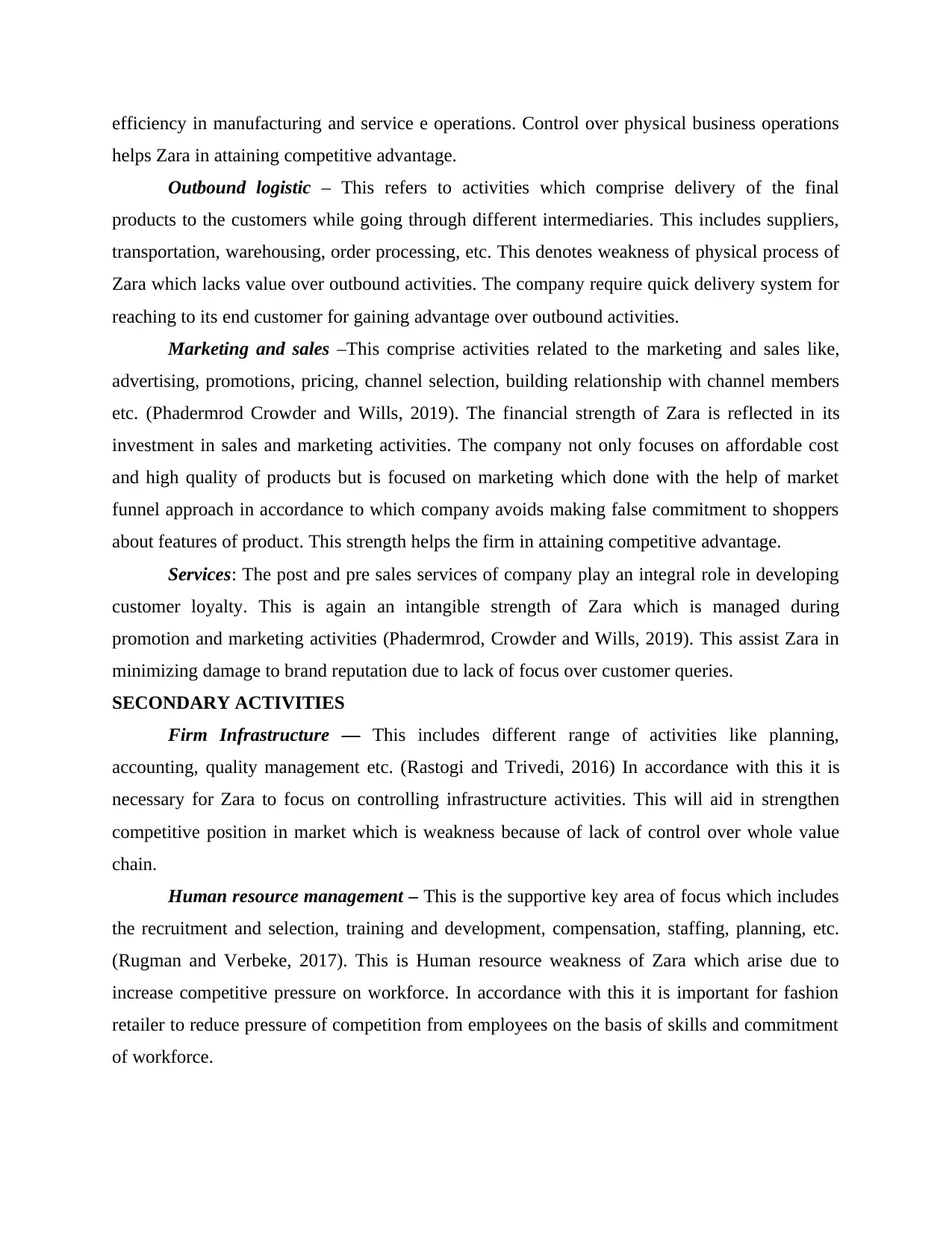
efficiency in manufacturing and service e operations. Control over physical business operations
helps Zara in attaining competitive advantage.
Outbound logistic – This refers to activities which comprise delivery of the final
products to the customers while going through different intermediaries. This includes suppliers,
transportation, warehousing, order processing, etc. This denotes weakness of physical process of
Zara which lacks value over outbound activities. The company require quick delivery system for
reaching to its end customer for gaining advantage over outbound activities.
Marketing and sales –This comprise activities related to the marketing and sales like,
advertising, promotions, pricing, channel selection, building relationship with channel members
etc. (Phadermrod Crowder and Wills, 2019). The financial strength of Zara is reflected in its
investment in sales and marketing activities. The company not only focuses on affordable cost
and high quality of products but is focused on marketing which done with the help of market
funnel approach in accordance to which company avoids making false commitment to shoppers
about features of product. This strength helps the firm in attaining competitive advantage.
Services: The post and pre sales services of company play an integral role in developing
customer loyalty. This is again an intangible strength of Zara which is managed during
promotion and marketing activities (Phadermrod, Crowder and Wills, 2019). This assist Zara in
minimizing damage to brand reputation due to lack of focus over customer queries.
SECONDARY ACTIVITIES
Firm Infrastructure — This includes different range of activities like planning,
accounting, quality management etc. (Rastogi and Trivedi, 2016) In accordance with this it is
necessary for Zara to focus on controlling infrastructure activities. This will aid in strengthen
competitive position in market which is weakness because of lack of control over whole value
chain.
Human resource management – This is the supportive key area of focus which includes
the recruitment and selection, training and development, compensation, staffing, planning, etc.
(Rugman and Verbeke, 2017). This is Human resource weakness of Zara which arise due to
increase competitive pressure on workforce. In accordance with this it is important for fashion
retailer to reduce pressure of competition from employees on the basis of skills and commitment
of workforce.
helps Zara in attaining competitive advantage.
Outbound logistic – This refers to activities which comprise delivery of the final
products to the customers while going through different intermediaries. This includes suppliers,
transportation, warehousing, order processing, etc. This denotes weakness of physical process of
Zara which lacks value over outbound activities. The company require quick delivery system for
reaching to its end customer for gaining advantage over outbound activities.
Marketing and sales –This comprise activities related to the marketing and sales like,
advertising, promotions, pricing, channel selection, building relationship with channel members
etc. (Phadermrod Crowder and Wills, 2019). The financial strength of Zara is reflected in its
investment in sales and marketing activities. The company not only focuses on affordable cost
and high quality of products but is focused on marketing which done with the help of market
funnel approach in accordance to which company avoids making false commitment to shoppers
about features of product. This strength helps the firm in attaining competitive advantage.
Services: The post and pre sales services of company play an integral role in developing
customer loyalty. This is again an intangible strength of Zara which is managed during
promotion and marketing activities (Phadermrod, Crowder and Wills, 2019). This assist Zara in
minimizing damage to brand reputation due to lack of focus over customer queries.
SECONDARY ACTIVITIES
Firm Infrastructure — This includes different range of activities like planning,
accounting, quality management etc. (Rastogi and Trivedi, 2016) In accordance with this it is
necessary for Zara to focus on controlling infrastructure activities. This will aid in strengthen
competitive position in market which is weakness because of lack of control over whole value
chain.
Human resource management – This is the supportive key area of focus which includes
the recruitment and selection, training and development, compensation, staffing, planning, etc.
(Rugman and Verbeke, 2017). This is Human resource weakness of Zara which arise due to
increase competitive pressure on workforce. In accordance with this it is important for fashion
retailer to reduce pressure of competition from employees on the basis of skills and commitment
of workforce.
Paraphrase This Document
Need a fresh take? Get an instant paraphrase of this document with our AI Paraphraser
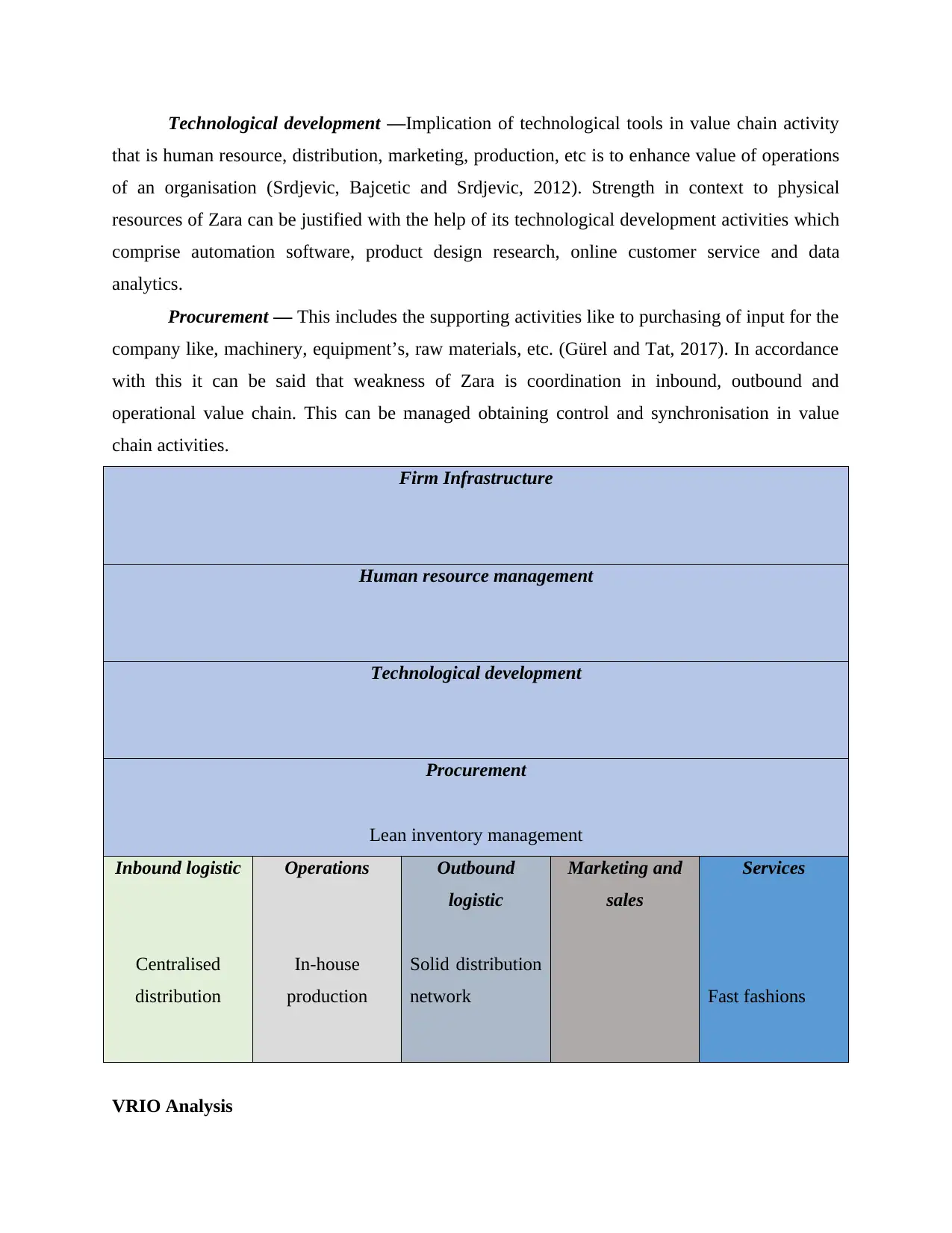
Technological development —Implication of technological tools in value chain activity
that is human resource, distribution, marketing, production, etc is to enhance value of operations
of an organisation (Srdjevic, Bajcetic and Srdjevic, 2012). Strength in context to physical
resources of Zara can be justified with the help of its technological development activities which
comprise automation software, product design research, online customer service and data
analytics.
Procurement — This includes the supporting activities like to purchasing of input for the
company like, machinery, equipment’s, raw materials, etc. (Gürel and Tat, 2017). In accordance
with this it can be said that weakness of Zara is coordination in inbound, outbound and
operational value chain. This can be managed obtaining control and synchronisation in value
chain activities.
Firm Infrastructure
Human resource management
Technological development
Procurement
Lean inventory management
Inbound logistic
Centralised
distribution
Operations
In-house
production
Outbound
logistic
Solid distribution
network
Marketing and
sales
Services
Fast fashions
VRIO Analysis
that is human resource, distribution, marketing, production, etc is to enhance value of operations
of an organisation (Srdjevic, Bajcetic and Srdjevic, 2012). Strength in context to physical
resources of Zara can be justified with the help of its technological development activities which
comprise automation software, product design research, online customer service and data
analytics.
Procurement — This includes the supporting activities like to purchasing of input for the
company like, machinery, equipment’s, raw materials, etc. (Gürel and Tat, 2017). In accordance
with this it can be said that weakness of Zara is coordination in inbound, outbound and
operational value chain. This can be managed obtaining control and synchronisation in value
chain activities.
Firm Infrastructure
Human resource management
Technological development
Procurement
Lean inventory management
Inbound logistic
Centralised
distribution
Operations
In-house
production
Outbound
logistic
Solid distribution
network
Marketing and
sales
Services
Fast fashions
VRIO Analysis
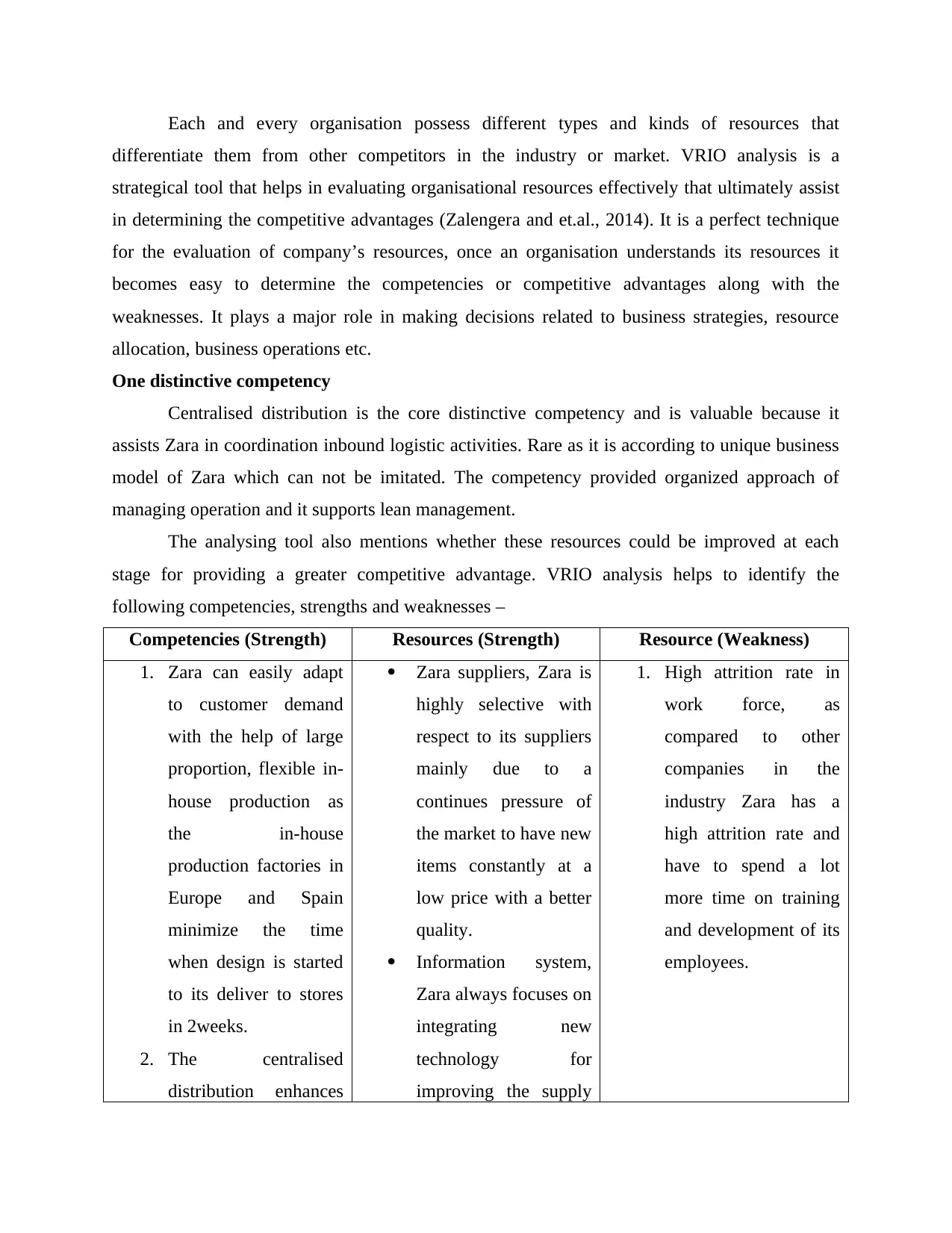
Each and every organisation possess different types and kinds of resources that
differentiate them from other competitors in the industry or market. VRIO analysis is a
strategical tool that helps in evaluating organisational resources effectively that ultimately assist
in determining the competitive advantages (Zalengera and et.al., 2014). It is a perfect technique
for the evaluation of company’s resources, once an organisation understands its resources it
becomes easy to determine the competencies or competitive advantages along with the
weaknesses. It plays a major role in making decisions related to business strategies, resource
allocation, business operations etc.
One distinctive competency
Centralised distribution is the core distinctive competency and is valuable because it
assists Zara in coordination inbound logistic activities. Rare as it is according to unique business
model of Zara which can not be imitated. The competency provided organized approach of
managing operation and it supports lean management.
The analysing tool also mentions whether these resources could be improved at each
stage for providing a greater competitive advantage. VRIO analysis helps to identify the
following competencies, strengths and weaknesses –
Competencies (Strength) Resources (Strength) Resource (Weakness)
1. Zara can easily adapt
to customer demand
with the help of large
proportion, flexible in-
house production as
the in-house
production factories in
Europe and Spain
minimize the time
when design is started
to its deliver to stores
in 2weeks.
2. The centralised
distribution enhances
Zara suppliers, Zara is
highly selective with
respect to its suppliers
mainly due to a
continues pressure of
the market to have new
items constantly at a
low price with a better
quality.
Information system,
Zara always focuses on
integrating new
technology for
improving the supply
1. High attrition rate in
work force, as
compared to other
companies in the
industry Zara has a
high attrition rate and
have to spend a lot
more time on training
and development of its
employees.
differentiate them from other competitors in the industry or market. VRIO analysis is a
strategical tool that helps in evaluating organisational resources effectively that ultimately assist
in determining the competitive advantages (Zalengera and et.al., 2014). It is a perfect technique
for the evaluation of company’s resources, once an organisation understands its resources it
becomes easy to determine the competencies or competitive advantages along with the
weaknesses. It plays a major role in making decisions related to business strategies, resource
allocation, business operations etc.
One distinctive competency
Centralised distribution is the core distinctive competency and is valuable because it
assists Zara in coordination inbound logistic activities. Rare as it is according to unique business
model of Zara which can not be imitated. The competency provided organized approach of
managing operation and it supports lean management.
The analysing tool also mentions whether these resources could be improved at each
stage for providing a greater competitive advantage. VRIO analysis helps to identify the
following competencies, strengths and weaknesses –
Competencies (Strength) Resources (Strength) Resource (Weakness)
1. Zara can easily adapt
to customer demand
with the help of large
proportion, flexible in-
house production as
the in-house
production factories in
Europe and Spain
minimize the time
when design is started
to its deliver to stores
in 2weeks.
2. The centralised
distribution enhances
Zara suppliers, Zara is
highly selective with
respect to its suppliers
mainly due to a
continues pressure of
the market to have new
items constantly at a
low price with a better
quality.
Information system,
Zara always focuses on
integrating new
technology for
improving the supply
1. High attrition rate in
work force, as
compared to other
companies in the
industry Zara has a
high attrition rate and
have to spend a lot
more time on training
and development of its
employees.
⊘ This is a preview!⊘
Do you want full access?
Subscribe today to unlock all pages.

Trusted by 1+ million students worldwide
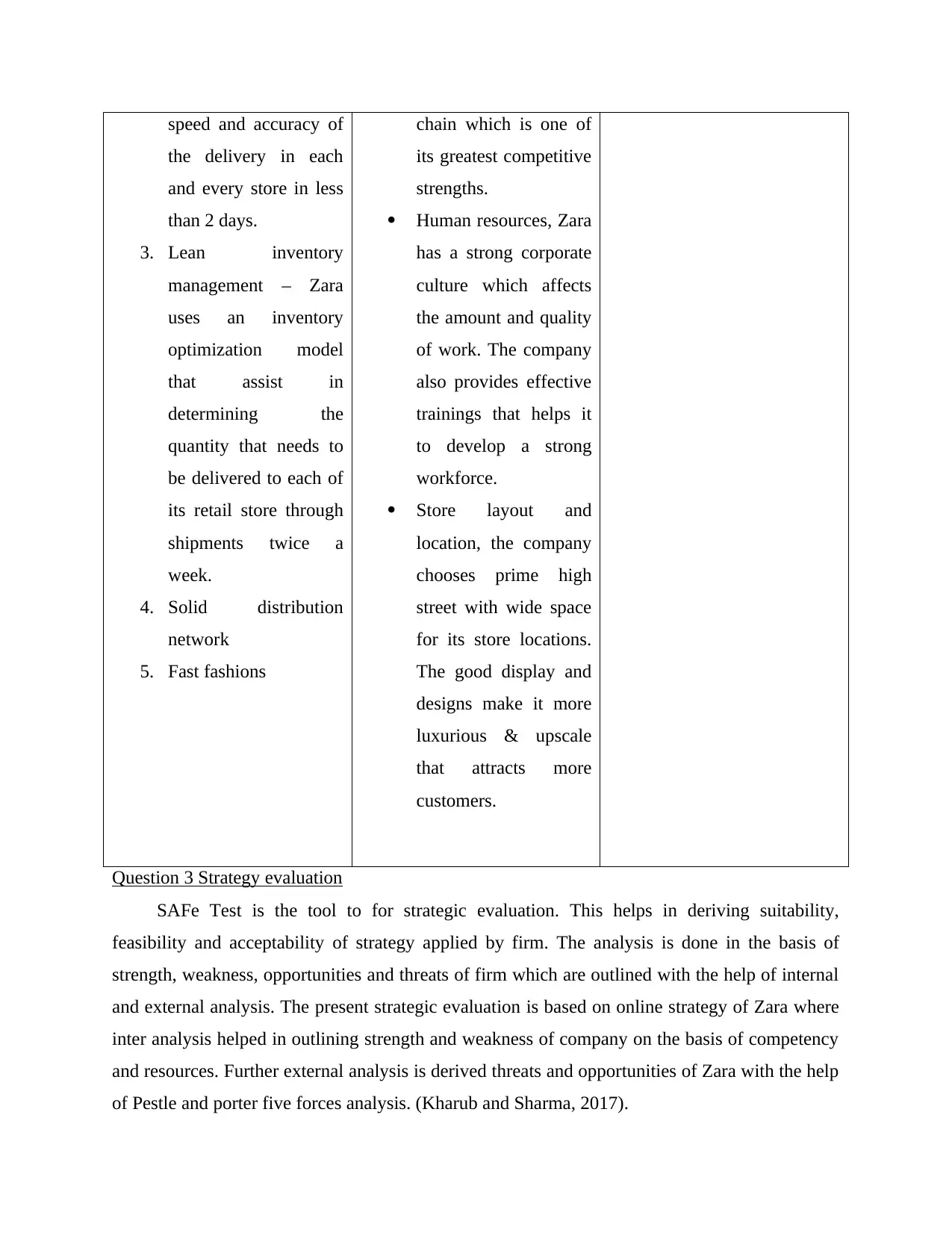
speed and accuracy of
the delivery in each
and every store in less
than 2 days.
3. Lean inventory
management – Zara
uses an inventory
optimization model
that assist in
determining the
quantity that needs to
be delivered to each of
its retail store through
shipments twice a
week.
4. Solid distribution
network
5. Fast fashions
chain which is one of
its greatest competitive
strengths.
Human resources, Zara
has a strong corporate
culture which affects
the amount and quality
of work. The company
also provides effective
trainings that helps it
to develop a strong
workforce.
Store layout and
location, the company
chooses prime high
street with wide space
for its store locations.
The good display and
designs make it more
luxurious & upscale
that attracts more
customers.
Question 3 Strategy evaluation
SAFe Test is the tool to for strategic evaluation. This helps in deriving suitability,
feasibility and acceptability of strategy applied by firm. The analysis is done in the basis of
strength, weakness, opportunities and threats of firm which are outlined with the help of internal
and external analysis. The present strategic evaluation is based on online strategy of Zara where
inter analysis helped in outlining strength and weakness of company on the basis of competency
and resources. Further external analysis is derived threats and opportunities of Zara with the help
of Pestle and porter five forces analysis. (Kharub and Sharma, 2017).
the delivery in each
and every store in less
than 2 days.
3. Lean inventory
management – Zara
uses an inventory
optimization model
that assist in
determining the
quantity that needs to
be delivered to each of
its retail store through
shipments twice a
week.
4. Solid distribution
network
5. Fast fashions
chain which is one of
its greatest competitive
strengths.
Human resources, Zara
has a strong corporate
culture which affects
the amount and quality
of work. The company
also provides effective
trainings that helps it
to develop a strong
workforce.
Store layout and
location, the company
chooses prime high
street with wide space
for its store locations.
The good display and
designs make it more
luxurious & upscale
that attracts more
customers.
Question 3 Strategy evaluation
SAFe Test is the tool to for strategic evaluation. This helps in deriving suitability,
feasibility and acceptability of strategy applied by firm. The analysis is done in the basis of
strength, weakness, opportunities and threats of firm which are outlined with the help of internal
and external analysis. The present strategic evaluation is based on online strategy of Zara where
inter analysis helped in outlining strength and weakness of company on the basis of competency
and resources. Further external analysis is derived threats and opportunities of Zara with the help
of Pestle and porter five forces analysis. (Kharub and Sharma, 2017).
Paraphrase This Document
Need a fresh take? Get an instant paraphrase of this document with our AI Paraphraser
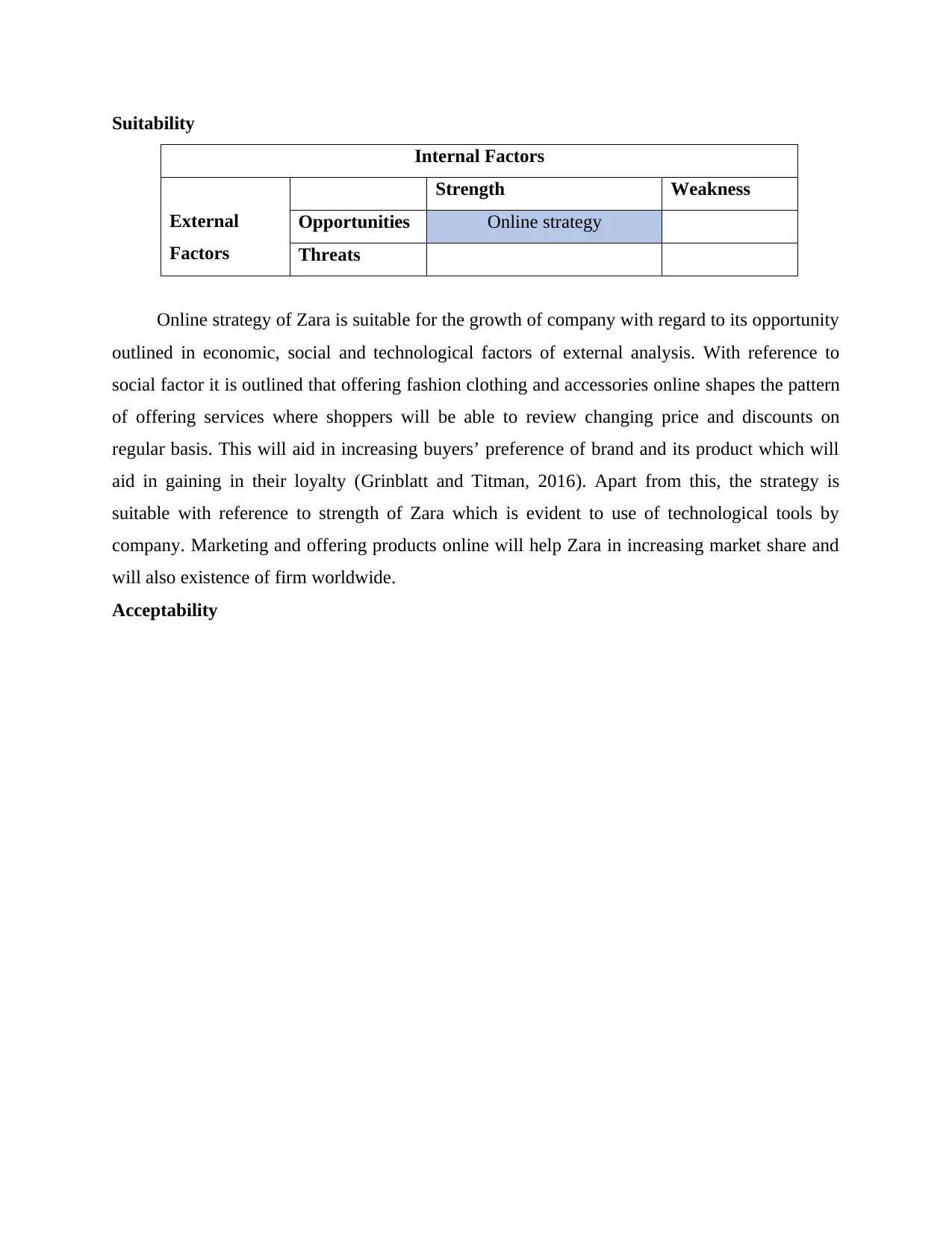
Suitability
Internal Factors
External
Factors
Strength Weakness
Opportunities Online strategy
Threats
Online strategy of Zara is suitable for the growth of company with regard to its opportunity
outlined in economic, social and technological factors of external analysis. With reference to
social factor it is outlined that offering fashion clothing and accessories online shapes the pattern
of offering services where shoppers will be able to review changing price and discounts on
regular basis. This will aid in increasing buyers’ preference of brand and its product which will
aid in gaining in their loyalty (Grinblatt and Titman, 2016). Apart from this, the strategy is
suitable with reference to strength of Zara which is evident to use of technological tools by
company. Marketing and offering products online will help Zara in increasing market share and
will also existence of firm worldwide.
Acceptability
Internal Factors
External
Factors
Strength Weakness
Opportunities Online strategy
Threats
Online strategy of Zara is suitable for the growth of company with regard to its opportunity
outlined in economic, social and technological factors of external analysis. With reference to
social factor it is outlined that offering fashion clothing and accessories online shapes the pattern
of offering services where shoppers will be able to review changing price and discounts on
regular basis. This will aid in increasing buyers’ preference of brand and its product which will
aid in gaining in their loyalty (Grinblatt and Titman, 2016). Apart from this, the strategy is
suitable with reference to strength of Zara which is evident to use of technological tools by
company. Marketing and offering products online will help Zara in increasing market share and
will also existence of firm worldwide.
Acceptability
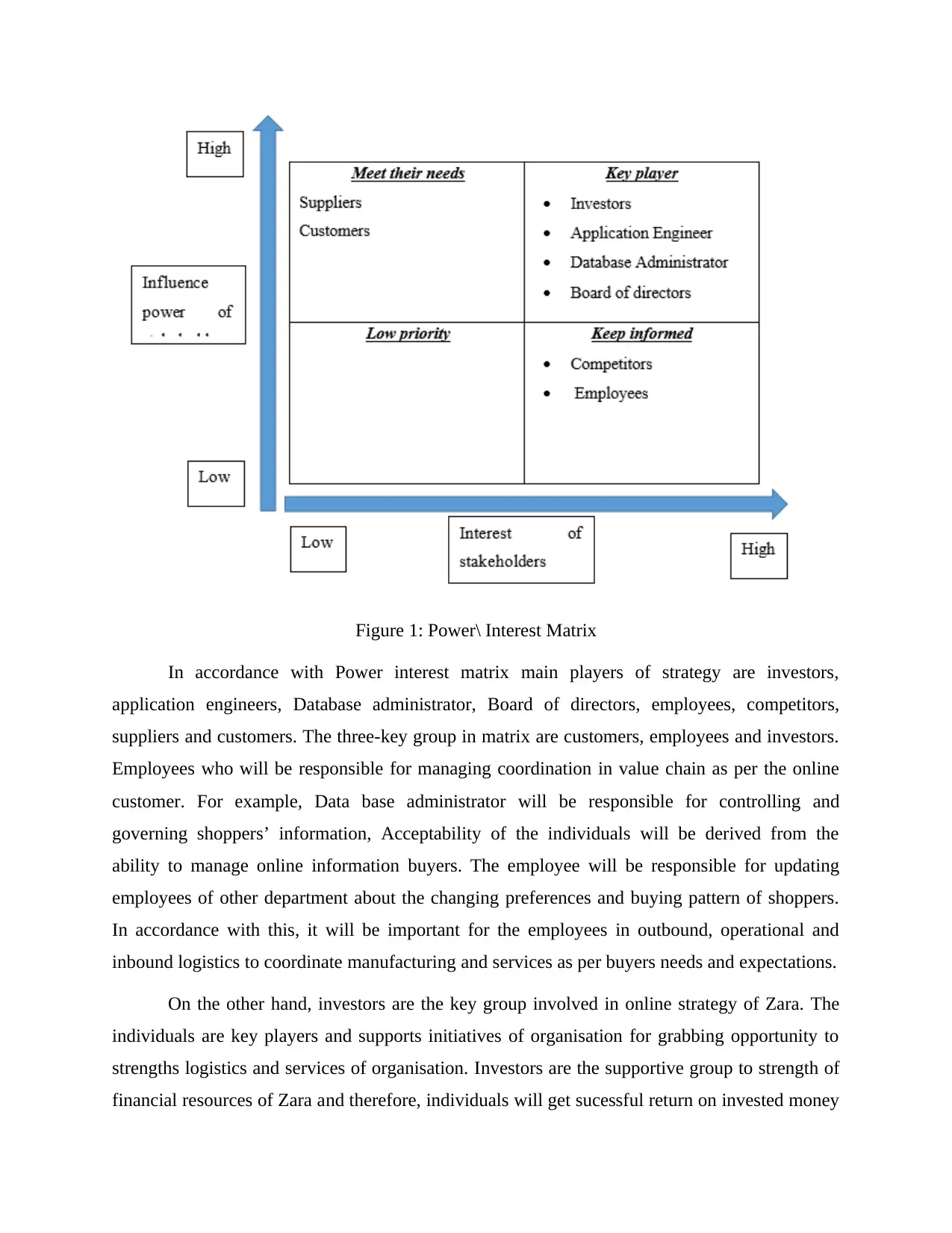
Figure 1: Power\ Interest Matrix
In accordance with Power interest matrix main players of strategy are investors,
application engineers, Database administrator, Board of directors, employees, competitors,
suppliers and customers. The three-key group in matrix are customers, employees and investors.
Employees who will be responsible for managing coordination in value chain as per the online
customer. For example, Data base administrator will be responsible for controlling and
governing shoppers’ information, Acceptability of the individuals will be derived from the
ability to manage online information buyers. The employee will be responsible for updating
employees of other department about the changing preferences and buying pattern of shoppers.
In accordance with this, it will be important for the employees in outbound, operational and
inbound logistics to coordinate manufacturing and services as per buyers needs and expectations.
On the other hand, investors are the key group involved in online strategy of Zara. The
individuals are key players and supports initiatives of organisation for grabbing opportunity to
strengths logistics and services of organisation. Investors are the supportive group to strength of
financial resources of Zara and therefore, individuals will get sucessful return on invested money
In accordance with Power interest matrix main players of strategy are investors,
application engineers, Database administrator, Board of directors, employees, competitors,
suppliers and customers. The three-key group in matrix are customers, employees and investors.
Employees who will be responsible for managing coordination in value chain as per the online
customer. For example, Data base administrator will be responsible for controlling and
governing shoppers’ information, Acceptability of the individuals will be derived from the
ability to manage online information buyers. The employee will be responsible for updating
employees of other department about the changing preferences and buying pattern of shoppers.
In accordance with this, it will be important for the employees in outbound, operational and
inbound logistics to coordinate manufacturing and services as per buyers needs and expectations.
On the other hand, investors are the key group involved in online strategy of Zara. The
individuals are key players and supports initiatives of organisation for grabbing opportunity to
strengths logistics and services of organisation. Investors are the supportive group to strength of
financial resources of Zara and therefore, individuals will get sucessful return on invested money
⊘ This is a preview!⊘
Do you want full access?
Subscribe today to unlock all pages.

Trusted by 1+ million students worldwide
1 out of 19
Related Documents
Your All-in-One AI-Powered Toolkit for Academic Success.
+13062052269
info@desklib.com
Available 24*7 on WhatsApp / Email
![[object Object]](/_next/static/media/star-bottom.7253800d.svg)
Unlock your academic potential
Copyright © 2020–2025 A2Z Services. All Rights Reserved. Developed and managed by ZUCOL.





